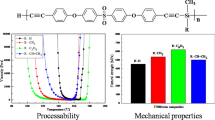Summary
The hydroxyl end groups of PPO resin, made from Cu/di-n-butylamine, 2,6-xylenol and oxygen, were capped with diphenyl chlorophosphate. A31P n.m.r. method was developed to distinguish the 2,6-xylenol and 2-methyl-6-(N,N-di-n-butylamino)methyl phenol end groups, which are directly related to the resin's thermal stability.
Similar content being viewed by others
References
Trademark of the General Electric Company.
S. R. Sandler, W. Karo “Polymer Synthesis” volume 1, Academic Press (1974) p. 239–247.
A.S.Hay, US Patent 4,028,341 (1977). J. G. Bennett and G.D. Cooper, US Patent 4,092,294 (1978). J. G. Bennett and G. D. Cooper, US Patent 3,639,656 (1972)
D. M. White, “A13C-NMR Study of Poly(2,6-Dimethyl-1,4-phenylene Oxide)s: Sites of Amine Incorporation,” in preparation.
S. Sosnowski, A. Duda, S. Stomkowski, S. Penczek; Makromol. Chem, Rapid Commun.5, 551–557 (1984).
A generous gift form Dr. J. E. Pickett, General Electric Company.




